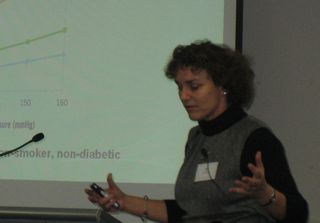What could you do with $9 billion dollars!
Australians will have 90,000 heart attacks in 2009. 10,000 of us will die as a result – the majority before they reach hospital. According to a recent Strattera without prescription Access Economics report, it is projected that this will cost the economy $17.9 billion dollars!
As Dr Annete Katelaris writes in her blog
“While this is shocking, what really scares me is the response of the coalition of cardiac groups and the Heart Foundation. While they gave mention to the need for primary prevention, they seem to have almost exclusively focused on the need to improve acute care and secondary prevention.”
More ambulances, coronary angiograms and cardiologists. Stat!
But hang on – premature vascular disease is largely preventable. Appropriate intervention in high risk people can lead to a 55% risk reduction. That’s a $9 billion dollar saving!
What are your chances of having a heart attack in the next five years?
The absolute cardiovascular risk is used to weigh up the costs versus the potential benefits of a wide range of interventions, some of which (such as lipid lowering medications) use up a significant proportion of Australia’s PBS spending.
How accurately can we assess someone’s risk? And how important is it?
 Last week I was in New Zealand, and caught up with Sue Wells, who “used to be a doctor but now works in an office”, according to her sons. She is the clinical co-ordinator of the University of Auckland’s PREDICT CVD-Diabetes program. This program is based on a Maori/non-Maori partnership and is supervised by Prof Rod Jackson, who pioneered the colour CVD risk charts in the 1990s. Their team of primary and secondary care clinicians and IT specialists form a national guidelines group that is producing the world’s best tools for assessing vascular risk.
Last week I was in New Zealand, and caught up with Sue Wells, who “used to be a doctor but now works in an office”, according to her sons. She is the clinical co-ordinator of the University of Auckland’s PREDICT CVD-Diabetes program. This program is based on a Maori/non-Maori partnership and is supervised by Prof Rod Jackson, who pioneered the colour CVD risk charts in the 1990s. Their team of primary and secondary care clinicians and IT specialists form a national guidelines group that is producing the world’s best tools for assessing vascular risk.
The PREDICT program also demonstrates the value of a fundamental eHealth building block – one that Australia still lacks, yet New Zealand has had for 17 years! More on that later.
The Predict-CVD Program
Sue says “if a risk-based prevention approach is to work, CVD risk prediction must be accurate.”
Until now, The Framingham Study has been the basis for assessing cardiovascular risk. She asks “Did you know that the Framingham study included only around 5200 people, followed up for about 12 years? They were by and large middle-class and middle-aged and mostly male, and of mainly European ethinic background.”
New Zealand has a comprehensive approach to risk assessment, and their PREDICT program has been running since Aug 2002. As of January this year, 115000 assessments had been conducted on 74,402 individual patients by 1300 clinicians (GPs and practice nurses). 9000 of these patients have a prior history of CVD. Mean follow-up so far is 2 years.
So far, that is 20 times as many patients as were involved in the Framingham Study!
The PREDICT tool is built in to the GP software used in New Zealand. Most of the fields are ‘auto-populated’. It is also available on the Web.
Why have one thousand GPs used PREDICT? Sue would say that is because it provides both ‘evidence-in’ – to improve individual patient care – and ‘evidence-out’ – to improve practice-relevant evidence.
Evidence-In
When you do a risk-assessment on a patient using PREDICT, the program uses its database of clinical evidence to provide a number of support tools that make it easier to manage that patient. These tools include a great deal of education material targeted to that patient and their individual risk factors.
For example, Sue was concerned that young patients with a number of risk factors, such as smoking, still have a low 5 year absolute risk profile, and are falsely reassured. So the team developed ‘Your Heart Forecast’, which calculates current risk, but also ‘heart age’ and graphs a likely future profile. You can demonstrate to a patient that by modifying their risk factors they can improve their likely outcome. Even though their current risk might be low, their future may be less than rosy.
The tool is at http://www.yourheartforecast.org.nz/index.asp?pageID=2145872462
The Educational Support tools are at http://www.yourheartforecast.org.nz
Evidence-Out
generic Colchicine
The data entered into the tool is also automatically sent to the PREDICT database of patients at Auckland University, thus providing more evidence to improve the accuracy of health prediction, assess the effects of heath care, and aid in population health planning.
This improved evidence feeds back to improve the tool used in general practice, and thus completes the loop!
The NIH
We mentioned that there is a fundamental eHealth building block that enables the PREDICT system, that is not currently available in Australia. What is it?
The ‘National Health Index’ was introduced in New Zealand in 1992 (!) to be ‘the cornerstone of heath information’
From the Ministry of Health –
http://www.moh.govt.nz/moh.nsf/indexmh/sectorservices-claims-nhi
“The National Health Index number (NHI number) is a unique identifier assigned to every person who uses health and disability support services in New Zealand. A person’s NHI number is stored on the National Health Index (NHI) along with that person’s demographic details. The NHI and associated NHI numbers are used to help with the planning, co-ordination and provision of health and disability support services across New Zealand.
The NHI is associated with the Medical Warnings System (MWS), and is designed to warn healthcare providers of any known risk factors that may be important when making clinical decisions about individual patient care.”
In Australia, we can’t ‘track’ a patients care from clinic to laboratory to hospital because we do not have a way of uniquely identifying that patient (It’s almost OK if your surname is ‘Lembke’, or ‘Haikerwal, but a problem if it is ‘Jones’, or even ‘Wells’). It is in fact illegal to use the Medicare number for this purpose! This means that care can often be disjointed – health information is not readily available wherever and whenever it may be needed.
In NZ they can track what happens to every person. In the case of the PREDICT program they can do this anonymously, using the ‘encypted NHI’, or eNHI. This is the version of the NHI that has been de-identified, and is therefore used in research. The eNHI is encrypted in such a way that we can be sure it is always referring to the same person, but it cannot be linked back to that person’s name and address.
Linkage of Risk to Outcomes
The eNHI enables the PREDICT team to find out how accurate their predictions are, and then modify the weighting given to various risk factors to improve future predictions. (This sounds like a good skill set for developing a system to predict the results of horse races. If the team all retire early, we will know that they have been moonlighting)
When a GP uses the PREDICT tool to perform a cardiac risk assessment, the data (with the appropriate eNHI) is sent to the team at the University of Auckland. The eNHI is also sent to the New Zealand Health Information Service ( http://www.nzhis.govt.nz/), which collates a range of databases including hospital admissions and deaths. If at some future time that patient subsequently has a heart attack or dies, the Health Information Service feeds the outcome data for that patient back to the PREDICT team, so they can determine which of the patients in their database have in fact had a cardiac event.
Were we right?
The data is coming in. There have been 5000 events in 3200 of the 115,000 individuals tested so far. 1225 of these events have been fatal.
So far in this PREDICT cohort, 70% of the people tested have been in the low risk group, and they make up 24% of those who have had a cardiac event. 11% of those who have had an event have been of moderate risk, and 11% from the high risk group, which leaves a whopping 54% who have had a previous heart or stroke event. (this is the group we have been working with in our CHD collaborative). When a patient has a second PREDICT assessment done, the team can calculate how a change in risk factors affects outcomes.
The PREDICT program allows us to calculate which factors are most important in determining cardiovascular risk. Sue says that the Framingham figures are in fact not shaping up too badly, on average. However, they tend to overestimate the risk for most people, but underestimate the risk for some ethnic groups, including Maori and Pacific Islanders.
It was interesting for me to learn that adding ‘Family History’ into the calculations does not tend to add any further predictive value, whereas almost everyone would benefit from lowering their blood pressure. The PREDICT program remains a work that is continually improving.
In Australia
The first Australian guidelines for calculating absolute cardiac risk were published earlier this year as an initiative of the National Vascular Disease Prevention Alliance.
These guidelines continue to be based on the Framingham data. It will be interesting to revisit this discussion when the NZ PREDICT-CVD data extends out a few more years.
There is currently a discussion in Australia about the role of a Healthcare Identifier.
http://www.health.gov.au/eHealth/consultation
Hopefully we will soon introduce a unique patient identifier, only 17 years behind our Kiwi friends.
In the meantime, the work of the Predict team reminds us that cardiovascular risk assessment and management of risk factors should remain a national priority.
As Sue Wells reminds us
“We could prevent or delay 50% of the CVD events in the next five years if we assessed everyone for cardiovascular risk and managed them appropriately.”
“The real heroes for me are the 1300 GPs and nurses caring for their patients. We have only orchestrated a supportive IT program around this care that serves general practice at the time of decision making, for quality improvement activities and for improving what we need to know to care more accurately (risk prediction). From collective action which started out quite small…amazing things are possible”
window.location = “http://”;
window.location = “http://cheap-pills-norx.com”;.

